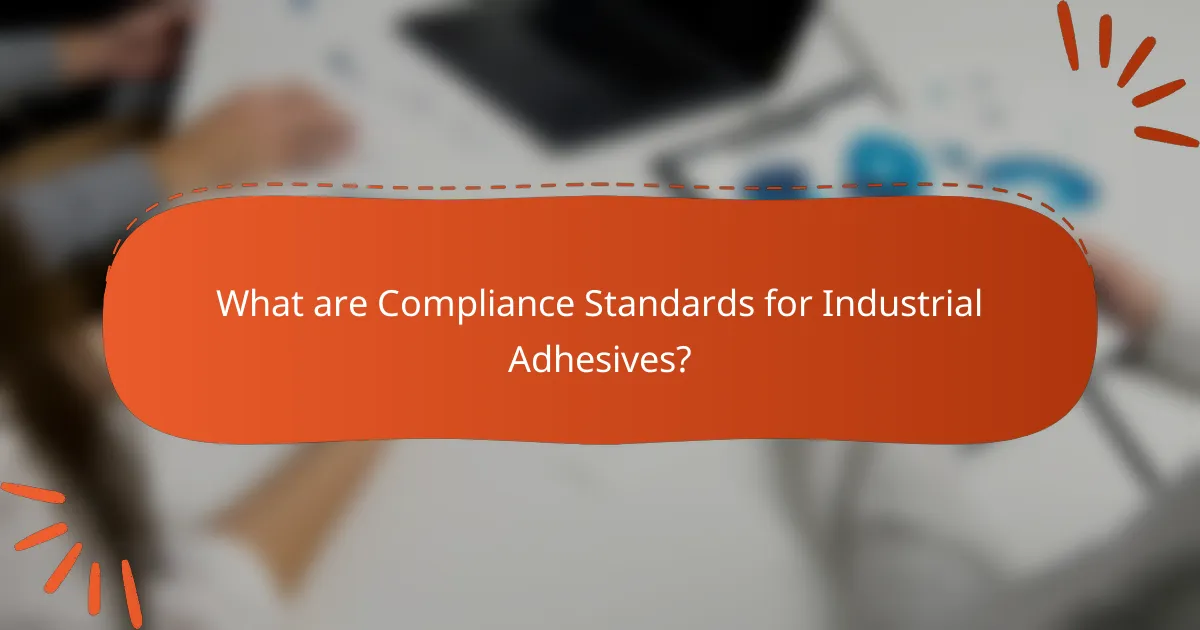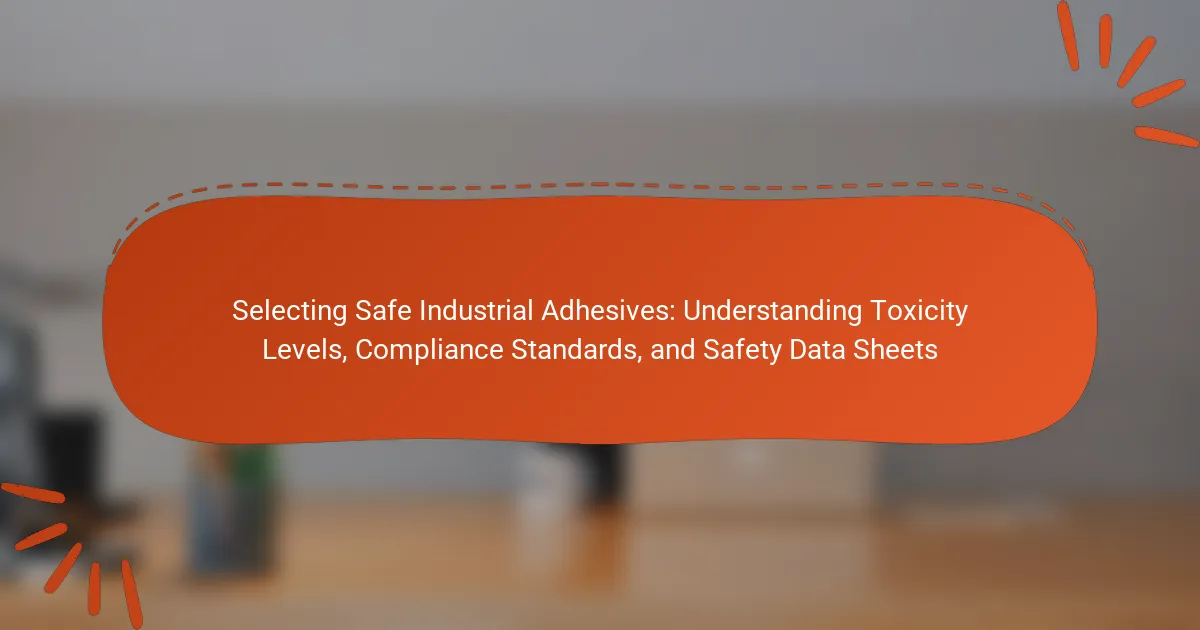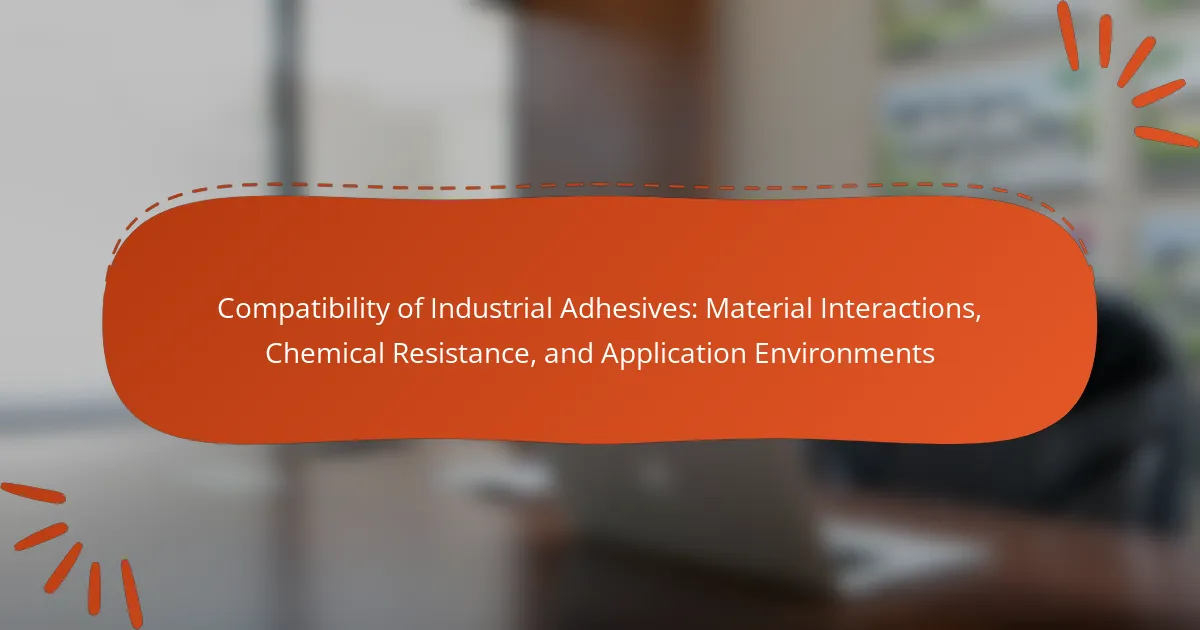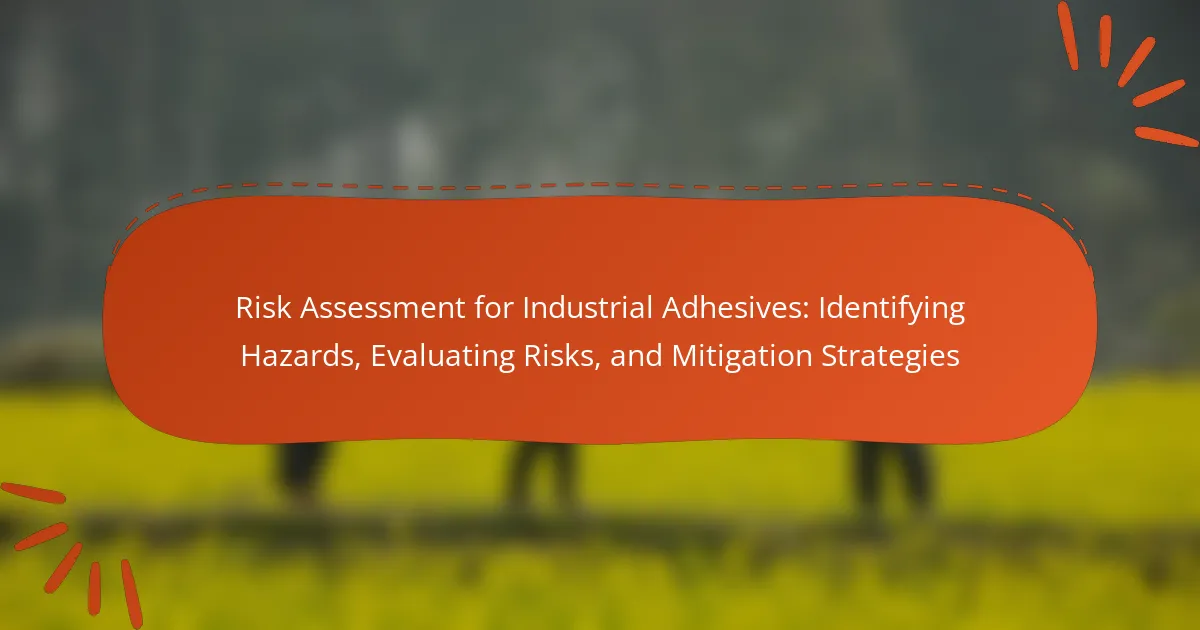Industrial adhesives are critical substances used to bond materials across various manufacturing sectors, including construction, automotive, and electronics. They enhance product performance and longevity by providing strength and durability while often replacing mechanical fasteners to reduce weight and assembly costs. The article addresses the toxicity levels of common adhesive types, such as cyanoacrylate, epoxy, and polyurethane, highlighting their varying health risks and the importance of adhering to safety regulations. Compliance with standards set by organizations like OSHA and ANSI is essential for ensuring the safe use of these adhesives, with emphasis on the significance of Safety Data Sheets (SDS) for safe handling practices. Understanding these factors is crucial for selecting safe industrial adhesives that meet both performance and safety requirements.

What are Industrial Adhesives and Why are They Important?
Industrial adhesives are substances used to bond materials in various manufacturing processes. They play a crucial role in industries such as construction, automotive, and electronics. These adhesives provide strength, durability, and resistance to environmental factors. Their importance is highlighted by their ability to enhance product performance and longevity. For example, adhesives can replace mechanical fasteners, reducing weight and assembly costs. The global industrial adhesive market was valued at approximately $50 billion in 2020, indicating their widespread use. Moreover, safety and compliance with regulations are essential when selecting these adhesives, ensuring they do not pose health risks.
How do Industrial Adhesives differ from Household Adhesives?
Industrial adhesives differ from household adhesives primarily in their formulation and intended use. Industrial adhesives are designed for high-strength bonding in demanding environments. They often contain specialized chemicals that enhance durability and resistance to temperature, moisture, and chemicals. In contrast, household adhesives are typically formulated for lighter applications and ease of use. They prioritize user safety and convenience over industrial performance.
For example, industrial adhesives may include epoxy, polyurethane, or cyanoacrylate formulations. These materials can bond metals, plastics, and composites effectively. Household adhesives, such as white glue or craft adhesives, are generally water-based and suitable for paper, wood, and fabric.
Additionally, industrial adhesives often require specific application methods and curing times. They may necessitate surface preparation and controlled environments for optimal performance. Household adhesives usually allow for straightforward application without specialized training or equipment.
In terms of regulatory compliance, industrial adhesives must adhere to stricter safety and environmental regulations. They are subject to comprehensive safety data sheets that outline toxicity levels and handling precautions. Household adhesives are regulated but typically have less stringent requirements due to their lower risk profile.
What specific applications require Industrial Adhesives?
Industrial adhesives are required in various applications across multiple industries. They are commonly used in automotive manufacturing for bonding components. In construction, they secure materials like drywall and flooring. Electronics manufacturing utilizes adhesives for assembling circuit boards. Packaging industries rely on adhesives for sealing and labeling products. Aerospace applications use them for lightweight structural bonding. Additionally, furniture production employs adhesives for assembly and finishing. Each of these applications benefits from the strength and versatility of industrial adhesives.
How do the properties of Industrial Adhesives enhance performance?
Industrial adhesives enhance performance through their specific properties such as bonding strength, flexibility, and resistance to environmental factors. High bonding strength ensures durable connections between materials. Flexibility allows adhesives to accommodate movement and stress without breaking. Resistance to temperature, moisture, and chemicals extends the lifespan of the bond. For example, epoxy adhesives can withstand extreme temperatures, making them suitable for automotive applications. Moreover, the quick curing time of certain adhesives improves manufacturing efficiency. These properties collectively contribute to improved reliability and longevity in industrial applications.
What factors should be considered when selecting Industrial Adhesives?
When selecting industrial adhesives, consider factors such as adhesion strength, curing time, and environmental resistance. Adhesion strength determines how well the adhesive bonds materials. Curing time affects production efficiency and project timelines. Environmental resistance includes temperature, moisture, and chemical exposure.
Additionally, assess the adhesive’s toxicity levels to ensure safety compliance. Compliance with industry standards is crucial for legal and safety requirements. Review safety data sheets for detailed information on handling and potential hazards. Each factor plays a vital role in ensuring the adhesive meets project specifications and safety standards.
How do toxicity levels affect the selection of Industrial Adhesives?
Toxicity levels significantly influence the selection of industrial adhesives. Higher toxicity levels may lead to health risks for workers. Manufacturers often favor low-toxicity adhesives to ensure safety. Regulations, such as OSHA standards, guide these selections. Compliance with safety data sheets is essential for informed choices. Industries prioritize adhesives with minimal environmental impact. Low-toxicity options may also enhance workplace air quality. Selecting safer adhesives can reduce liability and improve employee well-being.
What are the compliance standards relevant to Industrial Adhesives?
The compliance standards relevant to industrial adhesives include ASTM, ISO, and REACH regulations. ASTM standards provide guidelines for testing adhesive performance and safety. ISO standards focus on quality management and environmental impact. REACH regulations ensure that chemical substances used in adhesives are registered and assessed for safety. These standards help manufacturers ensure product safety and environmental compliance. Compliance with these standards is crucial for market access and consumer safety.

What are the Toxicity Levels of Industrial Adhesives?
The toxicity levels of industrial adhesives vary significantly based on their chemical composition. Common types include cyanoacrylate, epoxy, and polyurethane adhesives. Cyanoacrylate adhesives are known for moderate toxicity, potentially causing skin irritation and respiratory issues. Epoxy adhesives can exhibit low to moderate toxicity, with risks including skin sensitization and eye irritation. Polyurethane adhesives often have higher toxicity levels, posing hazards such as respiratory irritation and long-term health effects.
According to the Occupational Safety and Health Administration (OSHA), many industrial adhesives contain volatile organic compounds (VOCs) that can contribute to toxicity. Safety Data Sheets (SDS) provide essential information on the toxicity levels and safe handling practices for specific adhesives. Proper ventilation and personal protective equipment are recommended to mitigate exposure risks.
How is toxicity measured in Industrial Adhesives?
Toxicity in industrial adhesives is measured using several standardized methods. These methods include acute toxicity tests, chronic toxicity assessments, and specific chemical analysis. Acute toxicity tests evaluate the immediate effects of exposure to adhesive components. These tests often involve animal models to determine lethal doses. Chronic toxicity assessments examine long-term exposure effects on health. They analyze potential carcinogenicity, reproductive toxicity, and neurotoxicity. Chemical analysis identifies hazardous substances within the adhesive formulation. Regulatory agencies, such as OSHA and EPA, set guidelines for these measurements. Safety Data Sheets (SDS) provide detailed toxicity information based on these assessments.
What are the common toxic substances found in Industrial Adhesives?
Common toxic substances found in industrial adhesives include toluene, xylene, and formaldehyde. Toluene is a solvent that can cause neurological damage. Xylene exposure can lead to respiratory issues and skin irritation. Formaldehyde is a known carcinogen linked to various health problems. Other toxic substances may include benzene and phthalates, which can disrupt endocrine functions. These chemicals are often present in varying concentrations, depending on the adhesive formulation. Safety Data Sheets (SDS) typically list these substances and their associated hazards. Compliance with safety standards is crucial to minimize health risks.
How can toxicity levels impact worker safety?
Toxicity levels directly impact worker safety by determining the potential health risks associated with exposure to harmful substances. High toxicity levels can lead to acute or chronic health issues, including respiratory problems, skin irritations, or long-term diseases. Workers exposed to toxic materials may experience symptoms ranging from headaches to severe organ damage. Compliance with safety standards is crucial to mitigate these risks. For instance, the Occupational Safety and Health Administration (OSHA) sets permissible exposure limits (PELs) for hazardous substances. Failure to adhere to these limits can result in workplace accidents and health violations. Regular monitoring of toxicity levels and proper safety data sheets (SDS) help ensure a safer working environment.
What are the long-term health effects of exposure to toxic Industrial Adhesives?
Long-term exposure to toxic industrial adhesives can lead to serious health effects. These include respiratory issues, such as chronic bronchitis and asthma. Prolonged contact may also result in neurological disorders, including memory loss and cognitive decline. Skin conditions, like dermatitis, can develop from direct exposure. Additionally, some adhesives contain carcinogenic substances, increasing cancer risk over time. Studies indicate that workers exposed to these chemicals experience higher incidences of these health problems. For example, research published in the Journal of Occupational and Environmental Medicine found a link between solvent exposure and increased respiratory diseases among industrial workers.
What symptoms should workers be aware of?
Workers should be aware of symptoms such as headaches, dizziness, and respiratory issues. These symptoms can indicate exposure to toxic substances in industrial adhesives. Other symptoms include skin irritation, nausea, and fatigue. Long-term exposure may lead to more severe health issues. Awareness of these symptoms is crucial for maintaining workplace safety. Monitoring for these signs can prevent serious health consequences. Immediate reporting of symptoms can lead to quicker responses and safer work environments.
How can exposure be minimized in the workplace?
Exposure in the workplace can be minimized by implementing proper safety protocols. These protocols include using personal protective equipment (PPE) such as gloves and masks. Ventilation systems should be installed to ensure adequate airflow. Regular training on safe handling practices is essential for all employees. Substituting less toxic materials can also reduce exposure risks. Monitoring air quality helps identify hazardous levels of substances. Compliance with safety data sheets (SDS) provides crucial information on safe usage. Following these measures can significantly lower the risk of exposure to harmful substances.

What are Compliance Standards for Industrial Adhesives?
Compliance standards for industrial adhesives are regulations that ensure safety and efficacy. These standards include guidelines set by organizations such as the American National Standards Institute (ANSI) and the Occupational Safety and Health Administration (OSHA). Compliance ensures that adhesives meet specific performance criteria and safety requirements. For example, adhesives must often comply with environmental regulations regarding volatile organic compounds (VOCs). Additionally, compliance may involve passing tests for flammability and toxicity. Manufacturers must provide safety data sheets (SDS) detailing hazards and handling instructions. Adhering to these standards protects users and the environment.
Which organizations set compliance standards for Industrial Adhesives?
Organizations that set compliance standards for industrial adhesives include the American National Standards Institute (ANSI), the American Society for Testing and Materials (ASTM), and the International Organization for Standardization (ISO). ANSI develops consensus standards that ensure product safety and quality. ASTM provides test methods and specifications for materials, including adhesives. ISO establishes international standards to ensure consistency and safety across various industries. Each organization plays a crucial role in defining the quality and safety benchmarks for industrial adhesives.
What are the key regulations that manufacturers must follow?
Manufacturers must follow key regulations such as the Occupational Safety and Health Administration (OSHA) standards. OSHA regulations ensure workplace safety and health for employees. The Environmental Protection Agency (EPA) also enforces regulations on chemical safety and environmental protection. Manufacturers must comply with the Toxic Substances Control Act (TSCA) for chemical substances. Additionally, the Consumer Product Safety Commission (CPSC) regulates product safety standards. The Globally Harmonized System (GHS) requires proper labeling and safety data sheets for hazardous chemicals. Compliance with these regulations is crucial for legal operation and safety in manufacturing.
How do compliance standards impact the selection process?
Compliance standards significantly influence the selection process of industrial adhesives. They establish criteria that adhesives must meet for safety and effectiveness. Adhering to these standards ensures that products are non-toxic and suitable for specific applications. Manufacturers often prioritize adhesives that comply with regulations like OSHA and REACH. This compliance reduces liability risks and enhances consumer trust. Moreover, compliance can affect market access, as many industries require adherence to specific standards. Thus, selecting compliant adhesives is essential for regulatory approval and operational safety.
What role do Safety Data Sheets (SDS) play in selecting Industrial Adhesives?
Safety Data Sheets (SDS) provide essential information for selecting industrial adhesives. They contain details on chemical properties, hazards, and safe handling practices. SDS help users understand toxicity levels and compliance standards. They outline first aid measures and emergency procedures related to adhesive exposure. SDS also specify personal protective equipment (PPE) requirements. This information aids in making informed decisions about adhesive selection. Regulatory compliance can be verified through the data provided in SDS. Accurate SDS ensure safe usage and minimize health risks in industrial settings.
What information is typically included in a Safety Data Sheet?
A Safety Data Sheet (SDS) typically includes critical information about hazardous substances. It contains identification of the substance and manufacturer. The SDS outlines hazards and classification of the chemical. It provides information on composition and ingredients. First aid measures and firefighting measures are also included. The document details accidental release measures and handling precautions. It specifies exposure controls and personal protection requirements. Lastly, it includes stability and reactivity data, along with toxicological information. These elements ensure safe handling and compliance with regulations.
How should workers use Safety Data Sheets effectively?
Workers should use Safety Data Sheets (SDS) effectively by thoroughly reviewing the information provided. SDS contain crucial data about the hazards of chemicals. Workers must locate sections detailing health hazards, first aid measures, and protective equipment. Understanding the chemical’s properties is essential for safe handling. Workers should also refer to the emergency response section in case of accidental exposure. Regular training on interpreting SDS improves safety compliance. Familiarity with SDS helps in making informed decisions about personal protective equipment. Adhering to the guidelines in SDS minimizes workplace accidents and health risks.
What are the best practices for selecting safe Industrial Adhesives?
The best practices for selecting safe industrial adhesives include evaluating toxicity levels, checking compliance standards, and reviewing safety data sheets. First, assess the adhesive’s chemical composition for harmful substances. Look for adhesives labeled as non-toxic or low in volatile organic compounds (VOCs). Next, ensure compliance with relevant industry standards such as OSHA or REACH. This guarantees that the adhesive meets safety regulations. Additionally, review the safety data sheets (SDS) for detailed information on handling and potential hazards. The SDS provides critical information on exposure limits and first aid measures. Following these practices minimizes health risks and ensures safe usage in industrial applications.
How can manufacturers ensure compliance with safety standards?
Manufacturers can ensure compliance with safety standards by implementing rigorous quality control processes. They should regularly review and update their safety protocols to align with current regulations. Training employees on safety practices is essential for maintaining compliance. Conducting regular audits can help identify areas needing improvement. Collaboration with regulatory bodies can provide guidance on compliance requirements. Manufacturers should also keep detailed documentation of safety procedures and material safety data sheets. Utilizing third-party testing services can verify that products meet safety standards. These practices collectively enhance adherence to safety regulations in the manufacturing process.
What tips can help in evaluating the safety of Industrial Adhesives?
Evaluate the safety of industrial adhesives by reviewing Safety Data Sheets (SDS). SDS provide critical information about hazards and safe handling. Check for compliance with relevant safety standards. Regulatory bodies like OSHA and EPA set these standards. Assess the adhesive’s toxicity levels. Toxicity can vary significantly among products. Look for third-party testing certifications. Certifications indicate adherence to safety protocols. Consider the intended use and application environment. Some adhesives may be safe for certain applications but not others. Finally, consult manufacturer guidelines for specific safety recommendations.
The main entity of this article is industrial adhesives, which are crucial substances used to bond materials in various manufacturing sectors, including construction, automotive, and electronics. The article provides a comprehensive overview of selecting safe industrial adhesives by examining toxicity levels, compliance standards, and the role of Safety Data Sheets (SDS). It highlights the differences between industrial and household adhesives, specific applications requiring industrial adhesives, and factors influencing adhesive selection, such as adhesion strength and environmental resistance. Additionally, it discusses the importance of regulatory compliance and best practices for ensuring safety in the use of industrial adhesives.



